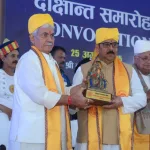CULTURAL PRACTICE
A vast and invaluable part of Kashmir’s cultural heritage—interwoven with the threads of ancient customs, vibrant rituals, and collective memory—is quietly fading before our eyes. This living legacy, once the very essence of our identity, now teeters on the brink of obscurity. With each passing day, our collective indifference seems to deepen, as if we’ve become spectators to the erosion of our own roots. In the rush to embrace globalized trends and the allure of foreign cultural elements—often unconsciously—we risk severing the very bonds that once defined who we are as a people.
And yet, despite the looming threat of cultural amnesia, not all is lost. The sands of time may be slipping swiftly through our fingers, but they have not yet run dry. What we need now is not despair, but intent—a shared, deliberate commitment to preserve and rejuvenate the rich tapestry of our traditions, practices, and indigenous knowledge systems that once fostered community, purpose, and identity.
Among the many cherished customs that once exemplified rural Kashmir’s spirit of unity and self-reliance, Halshri stands out as a beacon of communal strength and ecological wisdom. Rooted in deep cultural symbolism, Halshri was more than just an annual ritual—it was a celebration of cooperation, seasonal rhythm, and mutual respect.
The term itself derives from the Sanskrit word Hal, meaning plough (referred to locally as Albain), and Shri, which implies prosperity and sacredness, often tied to collective well-being. It represented a local ethos where community members came together to complete essential agricultural tasks, without waiting for or relying on government intervention.
Historically, in the rural heartlands of Kashmir, farming was a collective endeavor deeply attuned to the natural cycles of the land. There were no mechanical tools or government-supplied irrigation systems at their disposal. Yet, as soon as Son’th (spring)—the harbinger of cultivation—arrived, farmers would awaken with renewed vigor. They prepared their oxen (Da’nd Horr) and turned their attention to the lifelines of agriculture: the irrigation channels, rivulets, and small streams that nourished their fields.
Rather than waiting for official help, villagers took it upon themselves to clean, de-silt, and repair these water channels in anticipation of the sowing season. This voluntary effort—driven not by obligation but by tradition and shared responsibility—was a striking example of local resilience and self-governance. Every household would send a representative to join in the communal cleaning; creating a wave of action that not only revitalized the environment but also strengthened social bonds.
Halshri was thus not merely a functional activity. It was a socio-cultural movement, a ritual of ecological stewardship that resonated with values of cooperation, humility, and kinship. It taught the importance of teamwork, environmental conservation, and agricultural preparation. The initiative offered a host of benefits: it ensured better water distribution, prevented stagnation and drought, improved sanitation, and contributed to the overall wellbeing of the village. More than anything, it reaffirmed a collective identity rooted in mutual aid and respect for nature.
On a personal note, the memory of Halshri still lingers warmly in my mind. I recall how, days before the start of cultivation, each family in our Mohalla would take turns cleaning the small irrigation channel, Bate’ch, which even today continues to water our fields. Children would joyfully participate, lured by the tradition of Thari—crispy yellow fried rice—distributed as a token of celebration. Those were not just preparations for farming; they were festivals of unity, small but significant rituals that stitched the community together.
Today, the picture has dramatically changed. Modern farming increasingly leans on heavy machinery and government support for even the most basic agricultural needs. While technological advancement has brought convenience, it has also made us more dependent and, arguably, more disconnected from the land and from each other.
But perhaps it’s time to pause and reflect: could the most sustainable solutions still lie within our own communities? By rekindling the spirit of Halshri, we can reduce our dependence on external support, ensure efficient irrigation, and, most importantly, revive the sense of collective ownership that once made our villages thrive.
Let us not allow these cultural treasures to be reduced to mere memories or museum exhibits. As custodians of Kashmir’s rich heritage, we have a responsibility to ensure that such practices are not just remembered, but revived. They must echo through our farmlands, our gatherings, and our everyday lives—not only literally, in physical action, but metaphorically, in how we see ourselves as a people. In preserving Halshri, we are preserving more than a tradition—we are safeguarding the very soul of Kashmir.
(Writer is Educator and Author from Rafiabad. Feedback: [email protected])








